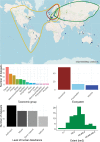A global database for metacommunity ecology, integrating species, traits, environment and space
- PMID: 31913312
- PMCID: PMC6949231
- DOI: 10.1038/s41597-019-0344-7
A global database for metacommunity ecology, integrating species, traits, environment and space
Erratum in
-
Author Correction: A global database for metacommunity ecology, integrating species, traits, environment and space.Sci Data. 2020 Mar 2;7(1):79. doi: 10.1038/s41597-020-0420-z. Sci Data. 2020. PMID: 32123181 Free PMC article.
Abstract
The use of functional information in the form of species traits plays an important role in explaining biodiversity patterns and responses to environmental changes. Although relationships between species composition, their traits, and the environment have been extensively studied on a case-by-case basis, results are variable, and it remains unclear how generalizable these relationships are across ecosystems, taxa and spatial scales. To address this gap, we collated 80 datasets from trait-based studies into a global database for metaCommunity Ecology: Species, Traits, Environment and Space; "CESTES". Each dataset includes four matrices: species community abundances or presences/absences across multiple sites, species trait information, environmental variables and spatial coordinates of the sampling sites. The CESTES database is a live database: it will be maintained and expanded in the future as new datasets become available. By its harmonized structure, and the diversity of ecosystem types, taxonomic groups, and spatial scales it covers, the CESTES database provides an important opportunity for synthetic trait-based research in community ecology.
Conflict of interest statement
The authors declare no competing interests.
Figures






Similar articles
-
When Do Traits Tell More Than Species about a Metacommunity? A Synthesis across Ecosystems and Scales.Am Nat. 2024 Jan;203(1):E1-E18. doi: 10.1086/727471. Epub 2023 Nov 27. Am Nat. 2024. PMID: 38207141
-
Trait-based ecology at large scales: Assessing functional trait correlations, phylogenetic constraints and spatial variability using open data.Glob Chang Biol. 2020 Dec;26(12):7255-7267. doi: 10.1111/gcb.15344. Epub 2020 Oct 18. Glob Chang Biol. 2020. PMID: 32896934
-
Trait sensitivities to seagrass fragmentation across spatial scales shape benthic community structure.J Anim Ecol. 2019 Nov;88(11):1743-1754. doi: 10.1111/1365-2656.13067. Epub 2019 Aug 19. J Anim Ecol. 2019. PMID: 31325173
-
The dimensionality and structure of species trait spaces.Ecol Lett. 2021 Sep;24(9):1988-2009. doi: 10.1111/ele.13778. Epub 2021 May 20. Ecol Lett. 2021. PMID: 34015168 Review.
-
Integrating species traits into species pools.Ecology. 2018 Jun;99(6):1265-1276. doi: 10.1002/ecy.2220. Ecology. 2018. PMID: 29569239 Review.
Cited by
-
Functional trait dataset of benthic macroinvertebrates in South Korean streams.Sci Data. 2023 Nov 28;10(1):838. doi: 10.1038/s41597-023-02678-y. Sci Data. 2023. PMID: 38017016 Free PMC article.
-
A roadmap to define and select aquatic biological traits at different scales of analysis.Sci Rep. 2023 Dec 22;13(1):22947. doi: 10.1038/s41598-023-50146-9. Sci Rep. 2023. PMID: 38135700 Free PMC article.
-
Estimating the movements of terrestrial animal populations using broad-scale occurrence data.Mov Ecol. 2021 Dec 11;9(1):60. doi: 10.1186/s40462-021-00294-2. Mov Ecol. 2021. PMID: 34895345 Free PMC article. Review.
-
Delineating reef fish trophic guilds with global gut content data synthesis and phylogeny.PLoS Biol. 2020 Dec 28;18(12):e3000702. doi: 10.1371/journal.pbio.3000702. eCollection 2020 Dec. PLoS Biol. 2020. PMID: 33370276 Free PMC article.
-
Distance decay 2.0 - A global synthesis of taxonomic and functional turnover in ecological communities.Glob Ecol Biogeogr. 2022 Jul;31(7):1399-1421. doi: 10.1111/geb.13513. Epub 2022 May 12. Glob Ecol Biogeogr. 2022. PMID: 35915625 Free PMC article.
References
-
- Vellend, M. The Theory of Ecological Communities (MPB-57). (Princeton University Press, 2016).
-
- Leibold, M. A. & Chase, J. M. Metacommunity Ecology. (Princeton University Press, 2017).
-
- Cadotte MW, Carscadden K, Mirotchnick N. Beyond species: functional diversity and the maintenance of ecological processes and services. Journal of Applied Ecology. 2011;48:1079–1087. doi: 10.1111/j.1365-2664.2011.02048.x. - DOI
-
- Lavorel S, Garnier E. Predicting changes in community composition and ecosystem functioning from plant traits: revisiting the Holy Grail. Functional Ecology. 2002;16:545–556. doi: 10.1046/j.1365-2435.2002.00664.x. - DOI
Publication types
MeSH terms
Grants and funding
- DFG FZT 118/Deutsche Forschungsgemeinschaft (German Research Foundation)/International
- DFG FZT 118/Deutsche Forschungsgemeinschaft (German Research Foundation)/International
- DFG FZT 118/Deutsche Forschungsgemeinschaft (German Research Foundation)/International
- DFG FZT 118/Deutsche Forschungsgemeinschaft (German Research Foundation)/International

